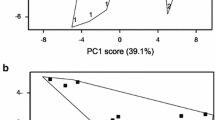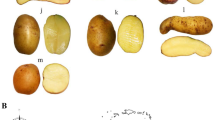Abstract
Potato (Solanum tuberosum L.) cv. Santé was grown over 2 years under both conventional and organic fertiliser and crop protection regimes. The tuber metabolome was analysed using mass-spectrometry (MS) based approaches, principally liquid chromatography (LC)–MS and gas chromatography (GC)–MS. Data were analysed using Principal Components Analysis (PCA) and Analysis of Variance (ANOVA) to assess any differences between production practices. GC–MS analysis of non-polar metabolites did not detect any statistically significant differences, but GC–MS analysis of polar compounds identified 83 metabolites showing significant differences in the metabolome between the fertiliser treatments. Of the 62 metabolites that were less abundant in tuber samples from organic compared with conventionally fertilised crops, consistent year on year differences were dominated by free amino acids. The effect on free amino acids is associated with the lower nitrogen (N) content of the organically grown potatoes in this instance (50 % lower than for conventional production). LC–MS provided indications that levels of certain glycoalkaloids may be lower under the organic fertiliser regime in one growing season. Differences associated with the crop protection measures used were much less consistent, and relatively small, compared with the fertiliser effects found.


Similar content being viewed by others
References
Abreu, P., Relva, A., Matthew, S., Gomes, Z., & Morais, Z. (2007). High-performance liquid chromatographic determination of glycoalkaloids in potatoes from conventional, integrated, and organic crop systems. Food Control, 18(1), 40–44.
Allison, D. B., Gadbury, G. L., Heo, M., Fernandez, J. R., Lee, C.-K., Prolla, T. A., et al. (2002). A mixture model approach for the analysis of microarray gene expression data. Computational Statistics and Data Analysis, 39, 1–16.
Amrein, T. M., Bachmann, S., Noti, A., et al. (2003). Potential of acrylamide formation, sugars, and free asparagine in potatoes: A comparison of cultivars and farming systems. Journal of Agricultural and Food Chemistry, 51(18), 5556–5560.
Barros, E., Lezar, S., Anttonen, M. J., et al. (2010). Comparison of two GM maize varieties with a near-isogenic non-GM variety using transcriptomics, proteomics and metabolomics. Plant Biotechnology Journal, 8(4), 436–451.
Benjamini, Y., & Hochberg, Y. (1995). Controlling the false discovery rate: A practical and powerful approach to multiple testing. Journal of the Royal Statistical Society Series B (Methodological), 57(1), 289–300.
Cooper, J., Sanderson, R., Cakmak, I., et al. (2011). Effect of organic and conventional crop rotation, fertilisation, and crop protection practices on metal contents in wheat (Triticum aestivum). Journal of Agricultural and Food Chemistry, 59(9), 4715–4724.
Dangour, A., Dodhia, S., Hayter, A., et al. (2009). Comparison of composition (nutrients and other substances) of organically and conventionally produced foodstuffs: A systematic review of the available literature. Report for the Food Standards Agency PAU221. http://www.food.gov.uk/multimedia/pdfs/organicreviewappendices.pdf. Accessed 07 June 2012.
Davies, H. V. (2010). A role for “omics” technologies in food safety assessment. Food Control, 21(2), 1601–1611.
Davies, H. V, Shepherd, L. V. T, Stewart, D., Frank, T., Röhlig, R. M., & Engel, K. H. (2010). Metabolome variability in crop plant species—When, where, how much and so what? Regulatory Toxicology and Pharmacology, 58(3 Suppl), S54–61.
FAO. (2009). The state of food insecurity in the world. Economic crises—Impacts and lessons learned. http://www.fao.org/docrep/012/i0876e/i0876e00.htm. Accessed 07 June 2012.
FAO. (2010). The state of food insecurity in the world. Addressing food insecurity in protracted crises. http://www.fao.org/publications/sofi-2010/en/. Accessed 07 June 2012.
FAO. (2011). The state of food insecurity in the world. How does international price volatility affect domestic economies and food security? http://www.fao.org/publications/sofi/en/. Accessed 07 June 2012.
Fernie, A. R., & Schauer, N. (2009). Metabolomics-assisted breeding: A viable option for crop improvement? Trends in Genetics, 25(1), 39–48.
Foresight. (2011). The future of food and farming: Challenges and choices for global sustainability. Final Project Report. The Government Office for Science, London. http://www.bis.gov.uk/assets/foresight/docs/food-and-farming/11-546-future-of-food-and-farming-report.pdf. Accessed 07 June 2012.
Frank, T., Röhlig, R. M., Davies, H. V., Barros, E., & Engel, K. H. (2012). Metabolite profiling of maize kernels – genetic modification versus environmental influence. Journal of Agricultural and Food Chemistry, 60(12), 3005–3012.
Friedman, M. (2006). Potato glycoalkaloids and metabolites: Roles in the plant and in the diet. Journal of Agricultural and Food Chemistry, 54(23), 8655–8681.
Hajšlová, J., Schulzová, V., Slanina, P., Janné, K., Hellenäs, K. E., & Andersson, C. (2005). Quality of organically and conventionally grown potatoes: Four-year study of micronutrients, metals, secondary metabolites, enzymic browning and organoleptic properties. Food Additives and Contaminants, 22(6), 514–534.
Hellenas, K.-E., & Branzell, C. (1995). Glycolalkaloider-solanin-i potatatiss. Var Föda, 47(8), 34–38.
Järvan, M. and Edesi,L. (2009). The effect of cultivation methods on the yield and biological quality of potato. Agronomy Research, 7(Special issue 1), 289–299.
Lehesranta, S. J., Koistinen, K. M., Massat, N., et al. (2007). Effects of agricultural production systems and their components on protein profiles of potato tubers. Proteomics, 7(4), 597–604.
Lombardo, S., Pandino, G., & Mauromicale, G. (2011). Nutritional and sensory characteristics of “early” potato cultivars under organic and conventional cultivation systems. Food Chemistry, 133(4), 1249–1254.
Lu, C., Hawkesford, M. J., Barraclough, P. B., et al. (2005). Markedly different gene expression in wheat grown with organic or inorganic fertiliser. Proceedings of the Royal Society Biological Sciences, 272(1575), 1901–1908.
Nishida, C., Uauy, R., Kumanyika, S. and Shetty, P. (2004). The Joint WHO/FAO Expert Consultation on diet, nutrition and the prevention of chronic diseases: Process, product and policy implications. Public Health Nutrition, 7(1A), 245–252.
Röhlig, R. M., Eder, J., & Engel, K. H. (2009). Metabolite profiling of maize grain: Differentiation due to genetics and environment. Metabolomics, 5(4), 459–477.
Röhlig, R. M., & Engel, K. H. (2010). Influence of the input system (conventional versus organic farming) on metabolite profiles of maize (Zea mays) kernels. Journal of Agricultural and Food Chemistry, 58(5), 3022–3030.
Shepherd, L. V. T., Alexander, C. A., Sungurtas, J. A., McNicol, J. W., Stewart, D., & Davies, H. V. (2010). Metabolomic analysis of the potato tuber Life cycle. Metabolomics, 6(2), 274–291.
Skogerson, K., Harrigan, G. G., Reynolds, T. L., et al. (2010). Impact of genetics and environment on the metabolite composition of maize grain. Journal of Agricultural and Food Chemistry, 58(6), 2600–3610.
Sumner, L. W., Amberg, A., Barrett, D., Beale, M. H., Beger, R., Daykin, C. A., et al. (2007). Proposed minimum reporting standards for chemical analysis. Chemical analysis working group (CAWG) metabolomics standards initiative (MSI). Metabolomics, 3(3), 211–221.
van Dijk, J. P., Cankar, K., Hendriksen, P. J. M., et al. (2012). The identification and interpretation of differences in the transcriptomes of organically and conventionally grown potato tubers. Journal of Agricultural and Food Chemistry, 60(9), 2090–2101.
van Dijk, J. P., Cankar, K., Scheffer, S. J., et al. (2009). Transcriptome analysis of potato tubers—Effects of different agricultural practices. Journal of Agricultural and Food Chemistry, 57(4), 1612–1623.
Woese, K., Lange, D., Boess, C., & Bogl, K. W. (1997). A comparison of organically and conventionally grown food-results of a review of the relevant literature. Journal of the Science of Food and Agriculture, 74(3), 281–293.
Wszelaki, A. L., Delwiche, J. F., Walker, S. D., Liggett, R. E., Scheerens, J. C., & Kleinhenz, M. D. (2005). Sensory quality and mineral and glycoalkaloid concentrations in organically and conventionally grown redskin potatoes (Solanum tuberosum). Journal of the Science of Food and Agriculture, 85(5), 720–726.
Zorb, C., Langenkamper, G., Betsche, T., Niehaus, K., & Barsch, A. (2006). Metabolite profiling of wheat grains (Triticum aestivum L.) from organic and conventional agriculture. Journal of Agricultural and Food Chemistry, 54(21), 8301–8306.
Acknowledgments
The authors would like to thank Paul Neave for technical support. The authors would also like to thank Sean Connor, Gary Dobson, Tom Shepherd and Susan Verrall for advice with data processing and metabolite identification. This work was supported by SAFEFOODS (EU FP6 Contract No Food-CT-2004-506446); Quality Low Input Food (QLIF; EU FP6 Contract No CT-2004-506358) and by the Scottish Government’s Rural and Environment Science and Analytical Services (RESAS) Division.
Author information
Authors and Affiliations
Corresponding author
Electronic supplementary material
Below is the link to the electronic supplementary material.
Rights and permissions
About this article
Cite this article
Shepherd, L.V.T., Hackett, C.A., Alexander, C.J. et al. Effect of agricultural production systems on the potato metabolome. Metabolomics 10, 212–224 (2014). https://doi.org/10.1007/s11306-013-0573-2
Received:
Accepted:
Published:
Issue Date:
DOI: https://doi.org/10.1007/s11306-013-0573-2




